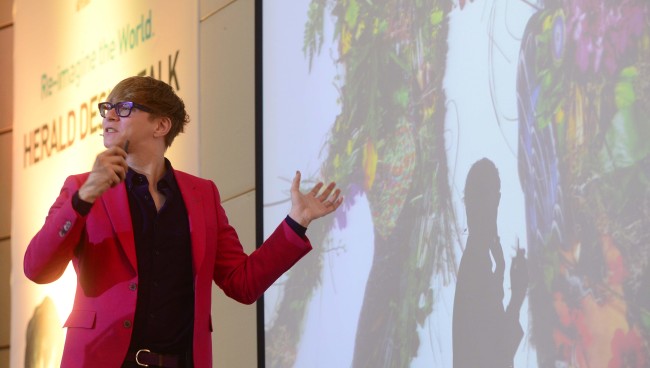A designer is a problem solver, British designer and illustrator Gary Card said at Wednesday’s Herald Design Talk in Seoul.
Defining himself as a designer, one with a highly diverse portfolio that ranges from t-shirt prints and retail shops to fashion editorials and sculptures, Card said that designers are distinguished from artists by the fact that they are given problems to work out.
“Designers are problem solvers. They are given a problem, and to solve that problem in the most vivid and exciting way they can,” Card said, adding that artists are concerned more with pursuing their own message.
 |
Set designer and illustrator Gary Card. (Park Hae-mook/The Korea Herald) |
Despite Card defining himself as a designer, he has fallen under such names as prop-maker, illustrator and set designer who has done collaborative works with the world’s top brands and figures.
He has also designed costumes and headpieces for Lady Gaga, including her bone mask for the Monster Ball Tour; created a set design for the interior of the concept retail store LN-CC in London; and designed a Christmas campaign for the luxury brand Loewe.
“I get scared of the word artist. I think of myself as a designer, I don’t know where my career is going, and that is the most exciting thing about what I do, the journey I am on.”
Card says that the inspiration for his wildly eccentric and sometimes sinister designs often come from his childhood. His works include sculptures made with masking tape, which he says is one of his favorite materials, that are designed to put in the mind of the viewer an abandoned amusement park.
“A lot of them come from my childhood. I am very excited about exploring things I remember, and turning them on their heads,” Card said. He said that the ideas for many of his works came from comics and other child-like things, citing the Christmas tree made of car parts he created for the British carmaker Vauxhall. It spun from the idea of “what would a Transformer tree” look like, referring to the cartoon and movie franchise.
Card describes his childhood, spent in the English seaside town of Bournemouth, as being spent mostly indoors despite living in a town with one of the United Kingdom’s most famous beaches. Card said that when his friends were playing on the beach, he would spend his time at home drawing and watching the sci-fi series “Star Trek.”
In addition to his “wild” style, Card is known for executing projects within very limited time, which he says is linked to his material-led style ― or staying true to the nature of the material being used.
“Material-led approach, it kind of led the way for me. It was fantastical, but it was very broad and true to the material we used,” he said.
“When I take on a project I am thinking how immersive can I make this experience.”
Although Card has grown into one of the leaders of his field, he says that seeing his works being edited ― which according to Card is a common occurrence ― remains a difficult thing to handle.
“It’s heartbreaking. You will spend hours with an idea. It may not be what they asked for, but you believe in the idea. It can be very upsetting, you love what you make, you nurture it, you want to show the world what you do but it can be very sad,” he said, adding that the “craziest thing” is not always what is wanted.
He went on to speak about his experience of working with singer Lady Gaga, saying that much of what he creates for the eccentric singer would be passed over.
While staying true to his style and artistic drive, Card doesn’t overlook the importance of commercial success.
“Wildly creative and commercial; both my favorite things. It is the perfect mixture of art and commerce,” Card said describing his work in designing shirts for the brand Comme des Garcons.
As for ways to overcome the “creator’s block,” Card suggests taking a step back from the problem at hand.
“It can be very hard. What I try and do is escape form the problem, the worst thing you can do is stare at a blank paper,” Card said.
“I come up with my best ideas when I am not thinking about them. See a film or taking public transport, it frees you up from the problem.”
By Choi He-suk (
cheesuk@heraldcorp.com)




![[Herald Interview] 'Trump will use tariffs as first line of defense for American manufacturing'](http://res.heraldm.com/phpwas/restmb_idxmake.php?idx=644&simg=/content/image/2024/11/26/20241126050017_0.jpg)

![[Health and care] Getting cancer young: Why cancer isn’t just an older person’s battle](http://res.heraldm.com/phpwas/restmb_idxmake.php?idx=644&simg=/content/image/2024/11/26/20241126050043_0.jpg)

